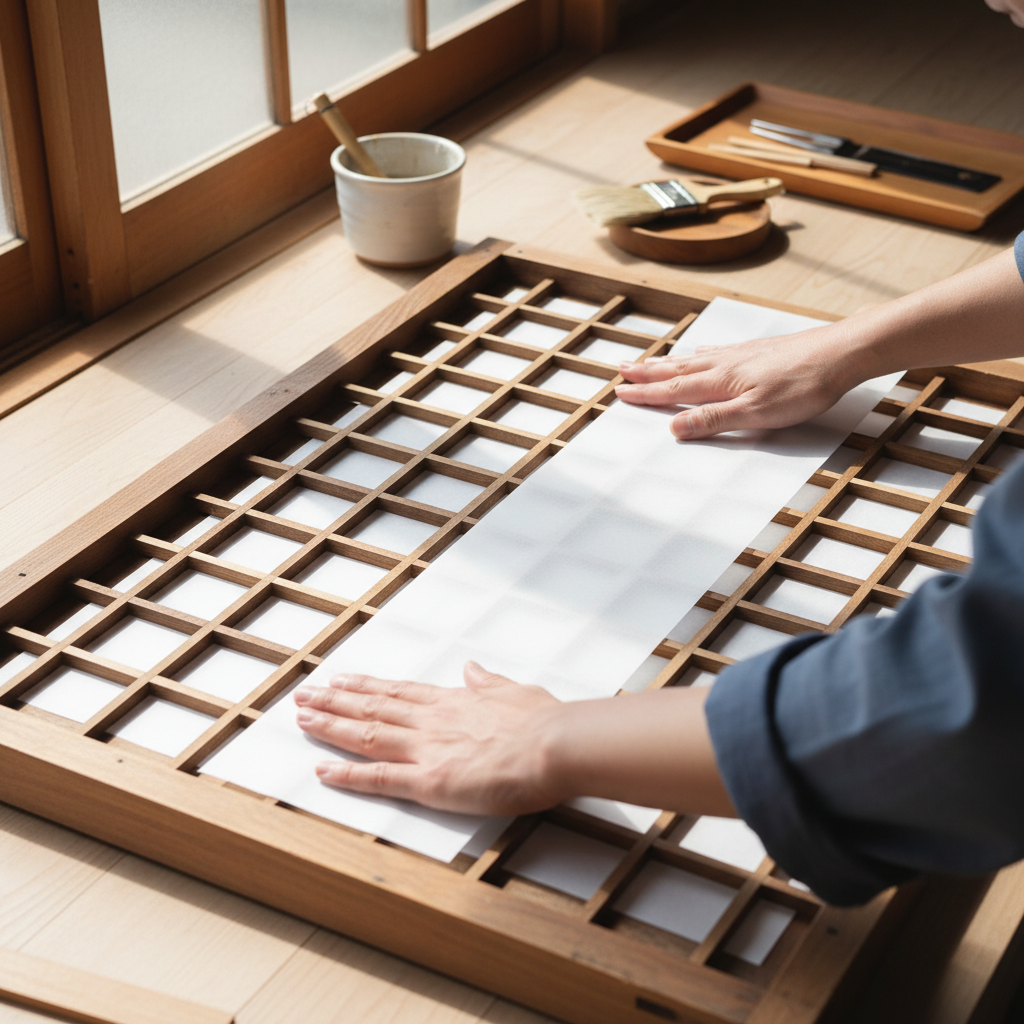From Scraps to Serenity: Crafting Your Own Shoji Doors
Ever walked into a room bathed in that soft, diffused light filtering through traditional Japanese shoji doors and just felt… peace? There’s something inherently calming about them – the gentle glow, the clean lines, the way they whisper privacy without feeling heavy or imposing. If you’ve dreamt of bringing that touch of tranquility into your own home, but perhaps thought it was too complex or too costly, then you’re in for a treat.
What if I told you that not only can you build these beautiful doors yourself, but you can do it using reclaimed wood? That’s right! Imagine giving new life to old timber, imbuing your shoji doors with a unique story and a charming, wabi-sabi aesthetic that simply can’t be replicated with new materials. It’s an incredibly rewarding project, blending sustainable living with timeless design. Trust me, the feeling of sliding open a door you built with your own hands, knowing it once had another life, is truly something special.
I’ve been down this road, measuring, cutting, gluing, and occasionally muttering to myself, and I can tell you, the journey is as enriching as the destination. So, grab a cup of tea, get comfortable, and let’s dive into making your very own Japanese-style shoji sliding doors from reclaimed wood. Ready to transform your space and perhaps, your woodworking skills?
Why Reclaimed Wood for Shoji? A Story in Every Grain
Before we even pick up a saw, let’s talk about the ‘why’ behind using reclaimed wood. Beyond the obvious environmental benefits of repurposing materials and reducing waste, there’s a profound aesthetic and philosophical appeal. Each piece of reclaimed wood comes with a history – perhaps it was part of an old barn, a forgotten fence, or even a piece of furniture that saw better days. This history manifests in unique knots, nail holes, wear patterns, and a patina that new wood simply can’t offer.
This character aligns beautifully with the Japanese concept of “wabi-sabi,” which celebrates imperfection, impermanence, and the beauty of natural aging. Your shoji doors won’t be pristine, factory-made replicas; they’ll be soulful, unique pieces that tell a story. They’ll have a warmth and authenticity that store-bought doors often lack. Plus, let’s be honest, sometimes reclaimed wood can be incredibly cost-effective, turning what might be a pricey project into an accessible dream.
Gathering Your Treasures: Sourcing and Preparing Your Wood
The first, and often most exciting, step is finding your reclaimed wood. This is where your ier treasure hunter comes out! Look for sources like:
- Architectural salvage yards: A goldmine for unique timbers.
- Pallets: Often free, but require careful deconstruction and cleaning.
- Old furniture: Dismantle dressers, tables, or cabinets for their wood.
- Construction sites: With permission, you might find scraps from demolition.
- Local listings: Check online marketplaces for free or cheap wood.
When selecting your wood, prioritize straightness, stability, and a relatively uniform grain. Avoid anything with signs of extensive rot, active insect infestation, or excessive warping. Once you have your bounty, prepare it:
- Clean it up: Remove any nails, screws, dirt, or loose paint. A wire brush and some elbow grease usually do the trick.
- Check for pests: Look for tiny holes or sawdust trails. If you suspect an issue, research heat treatment or chemical alternatives (use with caution!).
- Acclimate the wood: Bring the wood into your workshop or home for a few weeks. This allows it to adjust to your environment’s humidity, minimizing warping later.
- Mill it down: This is crucial. Even if your wood looks good, it likely isn’t perfectly square or flat. If you have access to a planer and jointer, great! If not, a good hand plane and careful sanding can get you pretty close. Aim for consistent thickness and width for all your frame pieces. This consistency is key for a successful shoji.
Tools of the Trade: What You’ll Need (and What’s Nice to Have)
You don’t need a fully stocked professional workshop, but a few key tools will make your life much easier:
- Measuring & Marking: Tape measure, ruler, combination square, pencil. Accuracy is paramount here.
- Cutting: Miter saw (for precise angle cuts), table saw (for ripping strips), or a good hand saw with a miter box.
- Shaping & Smoothing: Hand plane, sandpaper (various grits), random orbit sander.
- Joinery: Router with a straight bit (for grooves), chisels, mallet, drill, clamps (lots of clamps!). For frame joinery, dowel jigs or pocket hole jigs can simplify things if traditional mortise and tenon feels too intimidating.
- Adhesives: Wood glue (Titebond III is great for strength), rice paste or specific shoji paper glue.
- Safety Gear: Safety glasses, hearing protection, dust mask. Always.
Designing Your Shoji: Measurements and Proportions
This is where your vision takes shape. Carefully measure the opening where your shoji doors will go – height, width, and depth. Remember, shoji doors typically run on tracks, so you’ll need to account for the top guide and bottom ruer. For a pair of sliding doors, each door will be slightly wider than half the total opening to allow for overlap.
Traditional shoji often follow specific proportions, but don’t feel constrained. Sketch out your design: how many panels will each door have? What will the grid (kumiko) pattern look like? A simple rectangular grid is a great place to start for your first project. Consider the thickness of your wood – this will dictate the depth of your grooves and the overall robustness of the door.
Building the Frame: The Foundation of Your Door
With your wood milled and your design ready, it’s time to build the outer frame. This is the backbone of your shoji. For traditional strength, mortise and tenon joints are ideal, but for a DIY approach, robust dowel joints or even reinforced pocket hole joints can work well, provided they are glued and clamped properly. The key is squareness and rigidity.
Before assembly, you’ll need to cut grooves along the inside edges of your frame pieces where the kumiko (grid members) and the shoji paper will sit. A router with a straight bit is perfect for this, or a dado blade on a table saw. Make sure these grooves are uniform in depth and width. Once the grooves are cut, assemble and glue your frame, ensuring it’s perfectly square. Let it dry completely under clamp pressure.
Crafting the Kumiko: The Delicate Dance of the Grid
The kumiko grid is what gives shoji its distinctive look. This step requires patience and precision. Cut your kumiko strips to the desired width and thickness. For a simple rectangular grid, you’ll be creating half-lap joints where the horizontal and vertical pieces intersect. This means removing half the thickness of the wood where each piece crosses another. You can do this with a chisel, a table saw with a dado stack, or even a specialized kumiko jig if you’re getting serious.
Once all your kumiko pieces are cut and notched, dry-fit them into the grooves in your main frame. Make any necessary adjustments. When you’re happy with the fit, carefully glue the kumiko into the frame and to each other at their intersections. Use minimal glue, and wipe away any squeeze-out immediately. Clamp gently and evenly, allowing ample drying time.
The Shoji Paper: Light and Legacy
This is arguably the most satisfying part of the process – bringing light into your creation! You have a few options for paper:
- Traditional Washi Paper: Beautiful, breathable, and authentic. It’s delicate but incredibly rewarding to work with.
- Synthetic Shoji Paper: More durable, moisture-resistant, and often easier to apply for begiers.
Here’s a general approach to applying the paper:
- Prepare your adhesive: If using traditional rice paste, prepare it according to instructions. For synthetic paper, specific glues or even strong double-sided tape might be recommended. I personally found a thin, even coat of wood glue (like Titebond I or II) works well for synthetic paper, applied sparingly.
- Cut your paper: Cut pieces of paper slightly larger than each individual kumiko opening.
- Apply adhesive: Using a small brush, apply a thin, even bead of adhesive to the kumiko grid and the ier edges of the frame where the paper will adhere. Work one section at a time if you’re doing individual panels, or do the entire door if you’re using large sheets.
- Lay the paper: Carefully lay the paper over the adhesive. If using washi, you can lightly mist it with water after application to help it tighten as it dries, giving a drum-tight finish. For synthetic paper, gently smooth it out with your hands, working from the center outwards to avoid bubbles and wrinkles.
- Trim excess: Once the adhesive is dry (or mostly dry), carefully trim any excess paper using a sharp craft knife against a straight edge. Take your time here for clean lines.
Finishing Touches and Installation: Bringing it All Together
Your shoji doors are almost ready to grace your home! Before installation:
- Sand and Seal: Lightly sand the reclaimed wood frame (avoiding the paper, of course!). Apply a clear, non-yellowing finish like a penetrating oil or a water-based polyurethane. This protects the wood and enhances its natural beauty. The idea is to let the character of the reclaimed wood shine through, not to hide it.
- Install Tracks: Shoji doors run on top and bottom tracks. The top track usually has a wider groove to allow for lifting the door into place. The bottom track has a shallower, narrower groove or a raised ruer that the door’s bottom edge slides along. Ensure these tracks are perfectly level and parallel for smooth operation.
- Mount the Doors: Lift each door into the top track, then lower its bottom edge onto the bottom track. Check for smooth sliding action. You might need to make minor adjustments to the tracks or sand the door edges slightly for a perfect fit.
Embracing Imperfection: The Wabi-Sabi Spirit
As you stand back and admire your handiwork, remember the spirit of wabi-sabi. Your doors aren’t meant to be machine-perfect. The slight variations in the reclaimed wood, the tiny imperfections in your cuts, the subtle texture of the paper – these are not flaws. They are the unique hallmarks of a handmade piece, a testament to your effort, and the story of the materials you chose. They reflect authenticity and a coection to the natural world.
You’ve not just built a door; you’ve created a piece of functional art, infused with history and personal touch, that brings a serene, understated elegance to your space. And that, my friend, is something to be truly proud of.
Conclusion: A Doorway to Serenity, Crafted by You
Building your own Japanese-style shoji sliding doors from reclaimed wood is more than just a home improvement project; it’s a journey. It challenges your skills, tests your patience, and ultimately rewards you with a profound sense of accomplishment. From hunting for the perfect pieces of timber to meticulously applying the delicate paper, every step contributes to a final product that is rich in character and deeply personal.
You’ve transformed discarded materials into a gateway of diffused light and quiet contemplation. You’ve embraced sustainability and the philosophy of wabi-sabi, bringing a unique blend of history and tranquility into your home. So, slide open your new shoji doors, let that soft light wash over you, and bask in the serenity you’ve created. Who knows what other incredible projects await you?



